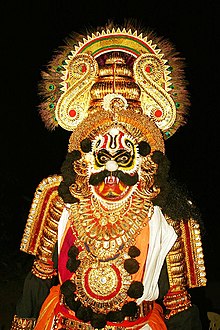Raksha people of Sri Lanka
|
Rakshasa as depicted in Yakshagana, an art form of coastal Karnataka
|
|
| Grouping | Legendary creature |
|---|---|
| Sub grouping | Demigod |
| Mythology |
Hindu mythology Buddhism |
| Other name(s) | Nri-chakshas Kravyads Rakshasi Manushya-Rakshasi Asura |
| Country | India and Nepal |
A Rakshasa (Sanskrit: राक्षस, rākṣasa) is a mythological being in Hindu mythology. As this mythology influenced other religions, the rakshasa was later incorporated into Buddhism. Rakshasas are also called 'Maneaters' (Nri-chakshas, Kravyads). A female rakshasa is known as a Rakshasi. A female Rakshasa in human form is a Manushya-Rakshasi. The terms Asura and Rakshasa are sometimes used interchangeably.
Rakshasas were believed to have been created from the breath of Brahma when he was asleep at the end of the Satya Yuga. As soon as they were created, they were so filled with bloodlust that they started eating Brahma himself. Brahma shouted "Rakshama!" (Sanskrit for "protect me!") and Vishnu came to his aid, banishing to Earth all Rakshasas (named after Brahma's cry for help).
Their literary origins can be traced to Vedic sources through Hymn 87 of the tenth mandala of the Rig Veda. They are classified amongst the Yatudhanas, mythological beings that consume raw flesh.
Some sources credit Kashyapa with the origin of the rakshasa. For artistic reasons, the Hymns of the Vedas do not do so. The knowledge of the Rakshasa lineage traceable to Kashyapa may have been known at the time of the compilation of the Vedas, but lineages are altogether foreign to the style of the Vedas and thus would have appeared out of place. This might explain why the Puranans and Hindu epics elaborate on their lineage, but the Vedas do not.
Kashyapa was married to the thirteen daughters of Daksha. Among them were Aditi, Diti and Danu. His sons with Danu are the Danavas, while those with Diti are the Daityas. His sons with Aditi are the Adityas, who are considered Devas and are also called Suras.
Rakshasas were most often depicted as ugly, fierce-looking and enormous creatures, with two fangs protruding from the top of the mouth and having sharp, claw-like fingernails. They are shown as being mean, growling like beasts, and as insatiable cannibals that could smell the scent of human flesh. Some of the more ferocious ones were shown with flaming red eyes and hair, drinking blood with their palms or from a human skull (similar to representations of vampires in later Western mythology). Generally they could fly, vanish, and had Maya (magical powers of illusion), which enabled them to change size at will and assume the form of any creature. The female equivalent of rakshasa is rakshasi.
...
Wikipedia

